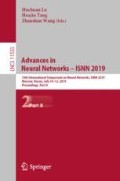Abstract
An adaptive Chirplet filter approach is proposed to deal with the aircraft recognition problem based on high-resolution range profiles. The Chirplet filter is a joint feature extraction and target identification method derived from the feed-forward neural networks, which consists of two layers: the Chirplet-atoms transform in the input layer is used for replacing the conventional sigmoid function, and the weights between the input and the output layer are taken as the linear classifier. The Chirplet-atoms parameters and the weights are adaptively adjusted by using the nonstationarity degree as the measurement of the features. The simulation results suggest that the adaptive Chirplet filter has advantages especially in noisy conditions.
Access this chapter
Tax calculation will be finalised at checkout
Purchases are for personal use only
References
Guo, Z.H., Li, D., Zhang, B.Y.: Survey of radar target recognition using one-dimensional high range resolution profiles (in Chinese). Syst. Eng. Electron. 35(1), 53–60 (2013)
Li, H.J., Yang, S.H.: Using range profiles as feature vectors to identify aerospace objects. IEEE Trans. Antennas Propag. 41(3), 261–268 (1993)
Zhang, X.D.: Modern Signal Processing (in Chinese), pp. 349–443. Tsinghua University Press, Beijing (2002)
Zhu, F., Zhang, X.D., Hu, Y.: Gabor filter approach to joint feature extraction and target recognition. IEEE Trans. Aerosp. Electron. Syst. 45(1), 17–30 (2009)
Guo, Z.H., Li, S.H.: One-dimensional frequency-domain features for aircraft recognition from radar range profiles. IEEE Trans. Aerosp. Electron. Syst. 46(4), 1880–1892 (2010)
Shaw, A.K., Paul, A.S., Williams, R.: Eigen-template-based HRR-ATR with multi-look and time-recursion. IEEE Trans. Aerosp. Electron. Syst. 49(4), 2369–2385 (2013)
Duin, R.P.W., Pekalska, E.: The science of pattern recognition. Achievements and perspectives. In: Duch, W., Mańdziuk, J. (eds.) Challenges for Computational Intelligence. SCI, vol. 63, pp. 221–259. Springer, Heidelberg (2007). https://doi.org/10.1007/978-3-540-71984-7_10
Liu, H., Feng, B., Chen, B., Du, L.: Radar high-resolution range profiles target recognition based on stable dictionary learning. IET Radar Sonar Navig. 10(2), 228–237 (2016)
Liu, W.B., Wang, Z.D., Liu, X.H., et al.: A survey of deep neural network architectures and their applications. Neurocomputing 234, 11–26 (2017)
Yin, H.Y., Guo, Z.H.: Radar HRRP target recognition with one-dimensional CNN (in Chinese). Telecommun. Eng. 58(10), 1121–1126 (2018)
Mann, S., Haykin, S.: The Chirplet transform: a generalization of Gabor’s logon transform. In: Vision Interface 1991, pp. 205–212. University of Calgary, Alberta (1991)
Mann, S., Haykin, S.: Adaptive “Chirplet” transform: an adaptive generalization of the wavelet transform. Opt. Eng. 31(6), 1243–1256 (1992)
Li, Y.F., Guo, Z.H.: Chirplet-atoms network approach to high-resolution range profiles automatic target recognition. In: 11th International Congress on Image and Signal Processing, Bio Medical Engineering and Informatics (CISP-BMEI), pp. 1–5. IEEE Press, Beijing (2018)
Mann, S., Haykin, S.: The Chirplet transform: physical considerations. IEEE Trans. Sig. Process. 43(11), 2745–2761 (1995)
Zhu, M., Jin, W.D., Pu, Y.W., Hu, L.Z.: Feature extraction of radar emitter signals based on Gaussian Chirplet atoms (in Chinese). J. Infrared Millimeter Waves 26(4), 302–306 (2007)
Macchi, O.: Optimization of adaptive identification for time-varying filters. IEEE Trans. Autom. Control 31(3), 283–287 (1986)
Haykin, S.: Adaptive Filter Theory, pp. 324–405. Prentice-Hall, Upper Saddle River (2013)
Acknowledgements
This work was supported by National Natural Science Foundation of China (61401252).
Author information
Authors and Affiliations
Corresponding author
Editor information
Editors and Affiliations
Rights and permissions
Copyright information
© 2019 Springer Nature Switzerland AG
About this paper
Cite this paper
Li, Y., Guo, Z. (2019). An Adaptive Chirplet Filter for Range Profiles Automatic Target Recognition. In: Lu, H., Tang, H., Wang, Z. (eds) Advances in Neural Networks – ISNN 2019. ISNN 2019. Lecture Notes in Computer Science(), vol 11555. Springer, Cham. https://doi.org/10.1007/978-3-030-22808-8_35
Download citation
DOI: https://doi.org/10.1007/978-3-030-22808-8_35
Published:
Publisher Name: Springer, Cham
Print ISBN: 978-3-030-22807-1
Online ISBN: 978-3-030-22808-8
eBook Packages: Computer ScienceComputer Science (R0)

